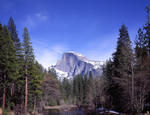The Slope and Vernon fires have been burning for nearly seven weeks in areas with little or no fire history. Both of these fires have aided significantly in restoring forest health by the return of fire to the landscape. The fires have been managed and monitored with little intervention by firefighters, allowing the fires to move in natural directions and filling in key pieces of the fire mosaic. Both of these fires are showing smaller increases in acreage due to cooler temperatures and shorter daylight hours.
In wilderness areas, Minimum Impact Management Tactics (MIMT) are utilized by using natural barriers of rock and lakes, or utilizing trails and past fires thereby lessening the use of aggressive hand tools, i.e. chain saws. Utilizing the minimal tool and natural features further reduces the work needed to rehabilitate the fire area. Firefighters do this without diverting their attention from the safety of themselves or the public. These adjustments firefighters make to effect minimum resource impacts are essential if the spirit of wilderness and National Parks is to be maintained.
Slope: (37 54.572 x 119 40.924; 6900’ el., Tuolumne Co). The Slope fire is approximately 1561 acres. Other than acreage changes, there is little new information to report. This lightning caused fire began July 25. The fire activity continues to be low in growth and spread due to cooler temperatures and higher humidities. Fifty percent of the perimeter is active, mostly to the south. It is burning in brush, timber and heavy accumulations of dead and down vegetation. The fire has continues to move toward the Harden road from White Wolf. Light smoke was visible and rising to 800’ above the ground and dispersing to the northeast. Light smoke may be visible along Tioga Rd, White Wolf area, O’Shaughnessy Dam of the Hetch Hetchy Reservoir, Rancheria trail area, and in the Tuolumne Meadows area. Five Yosemite Crew 7 firefighters are assigned. All trails to Pate Valley from the White Wolf campground area are closed due to safety concerns to hikers and backpackers
Vernon: (37 59.813 x 119 43.618; approximately 7000’ el., Tuolumne Co.) The acreage is at 756. It is creeping through brush and timber. The most active perimeters are to the northeast and west. Low fire activity has been observed by fire monitors through the week. Light smoke was dispersing to the northeast at 600’ above the ground. It is approximately three miles north of Hetch Hetchy Reservoir and one half mile south of Lake Vernon. There is significant lightning caused fire history near this fire; the most recent being the 2006 Frog, and the 2005 Wapama fires. Four Yosemite Crew 6 firefighters are assigned. The fire has crossed the trail to Lake Vernon from the Tiltill Valley Junction from the south and the trail is closed.
Cooperators for both the Vernon and Slope fires include the San Francisco Public Utilities Commission, and the Tuolumne County Air Pollution Control District.
Other park fires: The Tuolumne and Wildcat 2 fires are inactive and in patrol status.
Weather: A slight warming trend is developing through the week, and then a return of cooler temperatures is forecasted for the weekend.
Other fires affecting the Yosemite area: The Buckhorn fire (Sierra N.F.) and Pinecrest fire (Stanislaus N.F.) are producing localized thin smoke immediately to the south and the north of the park. Smoke from the Sheep fire (Sequoia and Kings Canyon N.P. and Sequoia N.F., and the Canyon fire, (Sequoia N.F.), continue to be visible along the Sierra Nevada Crest.
“The National Park Service manages wildland fire to protect the public, communities and infrastructure, conserve natural and cultural resources and restore and maintain ecological health.”
For Additional Information:
- Fire Information and Education Office: (209) 372-0480
- Current Yosemite Fire Activity Online: http://www.nps.gov/yose/parkmgmt/current_fire.htm
- Firenews: http://www.nps.gov/fire/public/pub_firenews.cfm
- Inciweb California: http://www.inciweb.org/state/5/
- NOAA satellite images of smoke: http://www.firedetect.noaa.gov/viewer.htm
- USGS regional webcam images of smoke movement: http://sierrafire.cr.usgs.gov/swifers/pages/WebCam.htm


